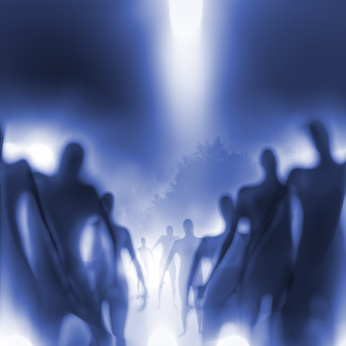If we begin to look at the views of religion and spiritualists, there is a basic premise to the argument for demons. That is, if God and angels exist, then so too must Satan and his demons, likewise where good spirits exist then malevolent spirits must also exist. Without going into a debate on the truth of religions, the Bible cites many examples of cases where Jesus healed people afflicted with demonic possession.
Of course, the scientific advancements of today have removed some previously viewed symptoms of possession. These would include mental illnesses such as schizophrenia, epilepsy and depression; psychiatric disorders now treated with medication. Movies on the theme of demonic possession have often taken the idea of people rebuking the possibility of psychiatric disorders and instead turn to the church, “The Exorcism of Emily Rose” being one such example. The issue with these sorts of movies is that it can often trivialise and even mock the idea of spiritual unrest in these people, and vilify the idea of parents turning to religion over hospitals for their ill children.
Indeed it’s a very murky and controversial area. The problem is exacerbated with movies and television programs exposing or highlighting the possibility of foul play by priests. The idea that priests may use electric nodes to shock patients into convulsions and spasms, as an indication of successful exorcisms, creates a very negative attitude toward the idea and institution of exorcism. The Vatican today claims that thousands of exorcisms are preformed every year, most being in third world countries where medicine may not be as advanced and superstition is more prevalent.
So yes, it is true that Western society has become much less superstitious and closed down to the idea of demons entering our world and causing harm. The same can be said for most spiritual enthusiasts in society, often looked upon as the weird corner that respectable persons would avoid. But let’s say that the idea of science knows best is wrong and ignorant. Science cannot provide an answer to everything or be any guarantor of truth. After all, science is only a methodology and finds itself shackled by empiricism and rationalism.
There may very well be a defined and real spiritual world, separated from our physical world. The transcendental idealism of philosopher Immanuel Kant highlights the idea of our physical world, the phenomena, or what we experience, and a spiritual realm, the noumena, that which we cannot understand or experience. Now Kant was not writing about demons, but this concept helps to paint a picture of what we mean when talking about these ideas and concepts.

For a person to open up the ability for a demon to get its foot in the door of our world, there are a few methods. This can range from Ouija boards, séances and even “games” such as “Bloody Mary”. It is said that children are most receptive to spiritual activity, and so demons find it easy to make contact with them. It’s a well-known movie line that the child in the house begins to talk to an “imaginary friend”, play games with it, and draw pictures of it. Quite creepy and disconcerting to watch; no one likes seeing children in horror movies. But it stems from this idea of a higher receptivity due to society not yet having closed their minds.
When a person has fallen victim to an infestation of demonic activity, there are certain symptoms often cited. The most classic of symptoms include the ideas becoming extremely dilated, changes to the voice, the ability to speak foreign languages fluently or in tongues, an aggressive and violent disposition and an aversion to God and other religious symbols. Levitation and seizures are also signs of demonic possession, with the former being the most hard to explain by medicine.
The person may first experience symptoms and happening around them before attacked. A sudden coldness in the room, animals reacting to seemingly nothing and knocks in repetitions of three can all be indicators of this. For this reason, many may mistake it for a regular haunting. Yet, there are distinct features reportedly unique to demonic haunting, such as being able to hear growling. Furthermore, it is said that demons have the ability to influence dreams and cause nightmares to weaken their victim. Activity is often said to be at its peak between the times of 12am to 3am, so identifying patterns is helpful in working out what is being dealt with. The most stark and worrying indication is that of physical harm to the person. Scratches, bruises, hair being pulled and the individual being pushed into walls, furniture or down the stairs are all cited as red alert warnings.
The opinion of a doctor should always be, and often is, the first port of call for any victim. This is important due to the possibility of previously discussed mental health issues being considered and examined. In many countries it is illegal to not take a sick child, for example, for appropriate medical help or removing a sick child from hospital without the consent of doctors. Therefore, a prescription of certain drugs may be given in the hopes of reducing or eliminating whatever condition it may be. In extreme cases, people have been placed in the care of mental health institutions for many years. Drugs being administered without need can do more damage than the hope to aid them. After medical assessment has been looked at, some may be referred to the church where an exorcism is deemed necessary.
Essentially, the exorcism is a prayer aided by holy symbols where the priest commands that the demon leave the inflicted person in the name of God. The demon will often put up a violent fight to the priest and the holy symbols, mocking God and lashing out with the person’s limbs. The exorcism of Anneliese Michael in 1975/6 took 67 sessions; it is not a case of one exorcism and the job’s done.
Consider the person to be like a suit of armour to the demon. The demon itself cannot be physically hurt, but the human it is controlling can be. For this reason, certain aspects of possession such as twisted limbs, seizures and choking can do serious damage that remains long after the exorcism is completed. The stresses on the body can be so great, both before and during an exorcism, that death may be resultant. Starvation that is brought about by the demon warping the mind of its victim can go along disguised as a choice of the person.
In instances where death has occurred, “demonic possession” is rarely an acceptable defence in a court of law. Indeed, it is the parents, carers and priests who have the responsibility placed on them, normally with the sentence of negligent care.
With all that has been said so far, it’s understandable for some to see it all as make believe and superstition. But it’s been said that just because one does not believe in something, it does not mean that the thing is not real and cannot affect them. That could cause a shift to an agnostic stance on the matter, but at the end of the day it really is subjective and up to each person to decide for themselves. All that could be suggested would be to have an open mind. Whether you are already a believer in the institution of exorcism and possibilities of possession, or a hard sceptic, it remains an interesting area to further read up on and learn about!
Related Articles...

Woman Still Missing Amid Claims of Kidnap by Djinn

Face of 'Vampire Woman' Reconstructed with Latest Technology

Skeleton Found Buried under Rocks to Prevent 'Rising'

Eerie Message Summoning Satan Found on Ancient 'Curse Tablet'

'After-school Satan Club' Alarms Residents in Connecticut Town

Mum Told to Flee Home after 'Demon' Lashes Out at Family

